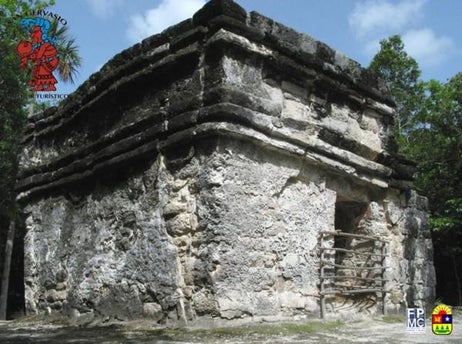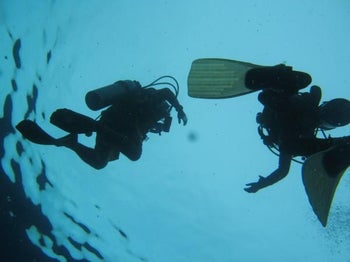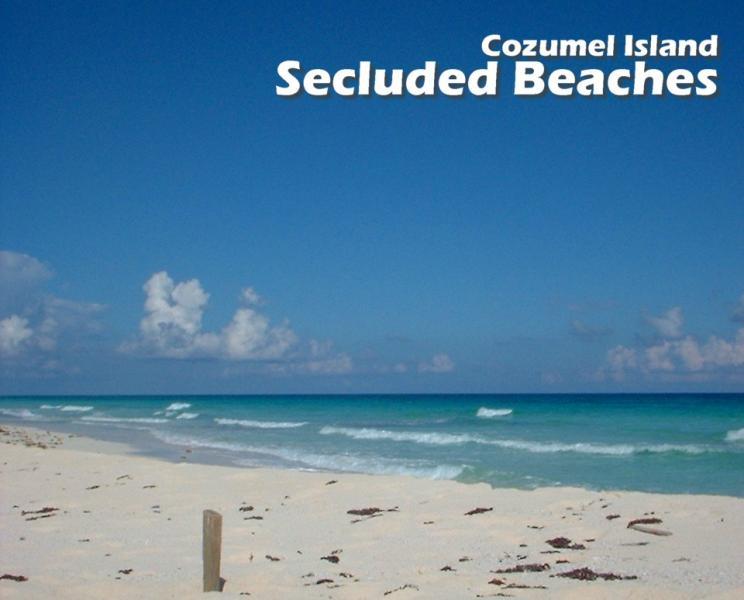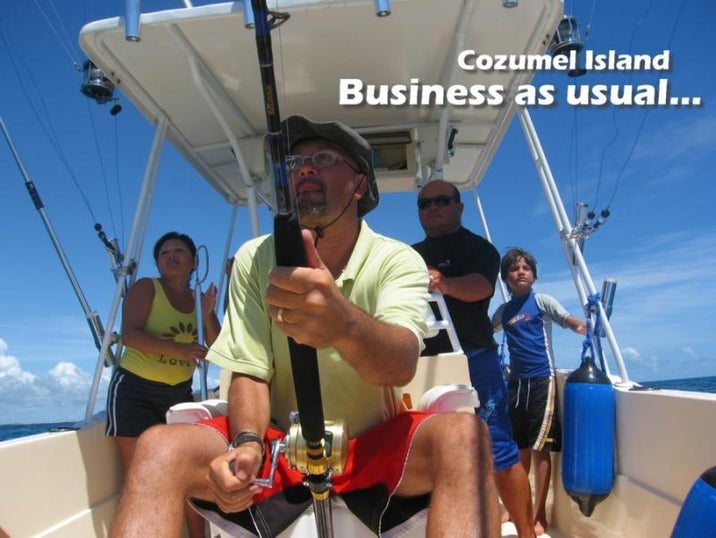COZUMEL ISLAND : THE SPOT AT THE END OF THE RAINBOW
INTRODUCTION : COZUMEL ISLAND A NATURAL PARADISE
Until the early sixties, Cozumel Island was a small laid-back fishermen’s village. It caught international attention when Jacques-Ives Cousteau, a world renowned diver and oceanographer, prepared a television documentary that showed the world the beauty of our island waters and reef formations.
Today Cozumel Island is a world class dive destination due to its marine biodiversity & crystalline blue waters. Even though resorts, restaurants, and other business have sprung up to serve visitors, when you visit Cozumel you will casually feel one step aside from rest of the world.
The subtropical climate (temp. ranging from low 70° F to high 90° F) creates the perfect environment for all sorts of marine life. Cozumel Island’s reef formations form part of the second largest barrier-reef in the world. Nature’s magnificence is available to divers and non divers alike. Snorkeling in shallow waters close to the beach is a once in a lifetime experience to enthusiasts of all ages. Sandy powdery beaches and temperate climate add up to holistic mind & body relaxation through nature contemplation.
Cozumel Island is the second largest inhabited island in Mexico, located a mere 11 miles off the eastern coast of the Yucatan peninsula. It is covered by tropical jungle and mangrove wetlands in approximately 80% of its surface. The remaining surface is constituted by San Miguel, a 100+ year old settlement currently populated by approximately 90,000 inhabitants. Similar to the Yucatan and Florida peninsulas, Cozumel Island is formed by a limestone plateau measuring 34 miles north to south by 10 miles east to west. Topography is significantly flat, lacking riverbeds and hill formations. Conversely, Cozumel Island counts with an extensive network of subsurface fresh water (aquifer) that silently flows underground through the porous limestone. Filtered by the limestone, subsurface fresh water flows to the ocean through underground caverns. In some cases, water erosion close to the surface evolve into sink holes (cenotes). These underwater environments have a unique endemic biodiversity, which combined with great visibility & unique rock formations create some of the most renowned cave and cavern diving in the world.
With the purpose of planning your next visit, we have outlined a weeklong program of activities. Feel free to review its content, and don’t hesitate to contact us for tips and updates.
Enjoy.
Cedral TEAM of Brokers
DAY 1 – COZUMEL ISLAND : OUR PRE-HISPANIC HERITAGE

It is not difficult to understand why Cozumel Island’s natural beauty attracted its Mayan dwellers centuries ago. The great Mayan civilization flourished from the Yucatan to Guatemala 2,000 years before the arrival of the Spanish conquistadores. Mayans populated Cozumel Island from 300 A.D. to 1500 A.D. Smaller archeological sites reminiscent of Mayan culture are scattered throughout the Island. The most significant site is San Gervasio. It is believed that San Gervasio served as a sacred city. Legend has it that this was once a sanctuary where women journeyed to worship Ixchel, the goddess of love and fertility. Ceremonial temples were built in her honor and as a sign of her gratitude; Ixchel presented her devotee followers with her favorite bird. This is why the Mayans named the Island Cuzamil-Pectin, which means Land of the Swallows.
San Gervasio is Cozumel Island’s largest archaeological site. Extending through 10 acres of lush vegetation, this site and restoration project gives us a sparkling glimpse into the ancient Maya civilization. Morning bilingual guided tours cost between $12 to $20 Dlls per group. You can also tour the site on your own. (consider bringing insect repellent before you venture on the nature walk into the site)
Admission fee $5.00 USD. Free entrance for children under 11 years. Park Hours: 7 A.M. through 4 P.M. year round. Transversal highway Km 7.5.
Top off your day with an afternoon horseback ride. Several tours are available for different sites around the island. Sunset rides are relaxing and usually include dinner outdoors.
DAY 2 – COZUMEL ISLAND : MARINE PARK |
|||||||||||||||||||||
|
The Park consists of 11,987.5 hectares, and includes marine, estuarine and land ecosystem which support the biological communities. Migratory and resident birds live here. Marine Park hosts an overwhelming variety of marine wildlife; soft & hard coral, hydrozoa, gorgonians, annelids, anemones, crustaceans, mollusks, echinoderms, sponges, algae, turtles & 500+ fish species. Park visitors are briefed by tour guides regarding the applicable restrictions while in the Park. For example, the recollection, touching or damaging of underwater organisms is strictly prohibited, biodegradable suntan lotion is mandatory; feeding fish or fishing is not permitted within the Park. Boat tours inside the Marine Park are guided by trained operators and an entrance fee is applicable. The clear intention is to preserve the beautiful environment through sustainable use of its resources for generations to come, as it has been for many past generations.
Conversely, dive enthusiasts normally choose to boat-dive the reef sites using the services of a Dive Shop. As a rule of thumb, dive boats will pick you up at your hotel pier, downtown pier or marina. You may even choose to head to a Beach Club, leave the non-diving relatives behind, and take off from the Beach Club pier.
|
|||||||||||||||||||||

 As a result of efforts by local activists, the vast majority of reef formations are environmentally protected as a marine refuge. The Cozumel Reefs – National Marine Park was declared in 1996. As of mid-1998, its visits are regulated by an Environmental Sustainability Program.
As a result of efforts by local activists, the vast majority of reef formations are environmentally protected as a marine refuge. The Cozumel Reefs – National Marine Park was declared in 1996. As of mid-1998, its visits are regulated by an Environmental Sustainability Program. To visit the park, you may choose to visit the park’s many Beach Clubs, where restaurants, restrooms, showers and gear rentals are available on site (kayaks, snorkeling and beach diving gear). Beach clubs offer different atmospheres to select from, lounge meditative, reggae bar, Carlos ‘n Charlie’s raucous. To find the perfect beach, Beach-Hopping is the soundest choice, renting a 4×4 Jeep; a must.
To visit the park, you may choose to visit the park’s many Beach Clubs, where restaurants, restrooms, showers and gear rentals are available on site (kayaks, snorkeling and beach diving gear). Beach clubs offer different atmospheres to select from, lounge meditative, reggae bar, Carlos ‘n Charlie’s raucous. To find the perfect beach, Beach-Hopping is the soundest choice, renting a 4×4 Jeep; a must.
 If you head to the windward side of the island, you’ll find deserted beaches and laid-back Beach Bars, where sand, sun, volleyball, hammocks, margaritas and Bob Marley are the order every day. Tikin’xic style fish cooked in open BBQs and seafood are served in shaded beach huts. Be prepared for rustic facilities.
If you head to the windward side of the island, you’ll find deserted beaches and laid-back Beach Bars, where sand, sun, volleyball, hammocks, margaritas and Bob Marley are the order every day. Tikin’xic style fish cooked in open BBQs and seafood are served in shaded beach huts. Be prepared for rustic facilities.
 Cozumel is one of the best deep-sea fishing sites in the Caribbean. If you’re looking for a good figh, look forward to : Sailfish, Blue Marlin, White Marilin, Dorado (also known as Mahi-Mahi), Wahoo, Tuna, Barracuda, Grouper, Snapper.
Cozumel is one of the best deep-sea fishing sites in the Caribbean. If you’re looking for a good figh, look forward to : Sailfish, Blue Marlin, White Marilin, Dorado (also known as Mahi-Mahi), Wahoo, Tuna, Barracuda, Grouper, Snapper.